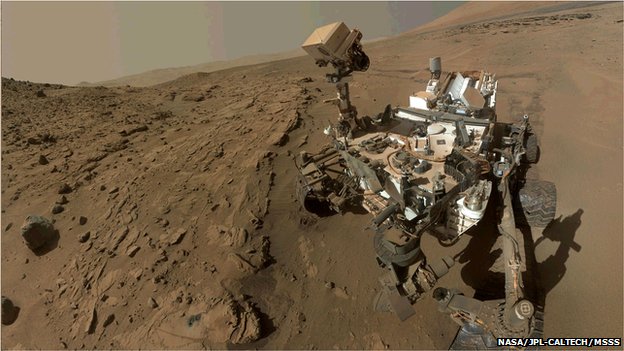The robot sees very low-level amounts constantly in the background, but it also has monitored a number of short-lived spikes that are 10 times higher.
Methane on the Red Planet is intriguing because here on Earth, 95% of the gas comes from microbial organisms.
Comment: This is actually an assumption, not proven fact. Oil is also assumed to be the result of the decomposition of once-living organic matter, even though it's extracted from way below the maximum theoretical extent of fossil layers.
Researchers have hung on to the hope that the molecule's signature at Mars might also indicate a life presence.
Comment: They can 'hope' all they want, but it's a false hope. See previous comment.
The Curiosity team cannot identify the source of its methane, but the leading candidate is underground stores that are periodically disturbed.
Curiosity scientist Sushil Atreya said it was possible that so-called clathrates were involved.
"These are molecular cages of water-ice in which methane gas is trapped. From time to time, these could be destabilised, perhaps by some mechanical or thermal stress, and the methane gas would be released to find its way up through cracks or fissures in the rock to enter the atmosphere," the University of Michigan professor told BBC News.
A likely source for such mechanical stress would be 'marsquakes':This, of course, still leaves open the question of how the methane (CH4) got into the clathrate stores in the first place.
Massive 'earth'-quake detected on Mars, 23 February 2012
...although thermal stress is another possibility: maybe Mars' dormant volcanoes, vents and calderas are becoming active like they are on Earth?
It could have come from Martian bugs; it could also have come from a natural process, such as serpentinisation, which sees methane produced when water interacts with certain rock types.
At the moment, it is all speculation. But at least Curiosity has now made the detection.
Enriched samples
It was concerning that for many months the robot could not see a gas that was being observed by orbiting spacecraft at Mars and by telescopes at Earth.
People were beginning to wonder if the other sightings were reliable.
Curiosity is located in a deep bowl on Mars' equator known as Gale Crater.
It has been sucking in Martian air and scanning its components since shortly after landing in August 2012.
For gases that have very low concentrations in the atmosphere, the robot can employ a special technique in which it expels the most abundant molecule - carbon dioxide - before analysing the sample.
This has the effect of enriching and amplifying any residual chemistry.
And in doing this for methane, Curiosity finds that there is a persistent signature of about 0.7 parts per billion by volume.
To put that in context, in Earth's atmosphere, you would expect to see around 1,750 parts per billion by volume of air. It is the difference between a few tens of thousands of tonnes in Mars' air, and the many billions of tonnes that exist in Earth's atmosphere.
Comment: There is such an abundant amount in Earth's atmosphere NOW because more is being released at this time. The quantity of methane in Earth's atmosphere is NOT a constant. Methane levels spike in ice core data... at the boundaries of climate shifts into and out of ice ages.
The background detection is a bit lower than theoretical models had anticipated. It was thought that just the action of sunlight on the carbon compounds in cosmic dust falling to Mars would release a certain level of CH4.
"I don't think there is a big disagreement there; our result is to within an order of magnitude. That's quite satisfying," said Dr Paul Mahaffy, the lead investigator on Curiosity's Surface Analysis at Mars instrument.
Life's preference
The spikes in methane that Curiosity saw occurred on four occasions during the course of a two-month period.
They varied between about 7 and 9 parts per billion by volume.
It is likely, the team says, that the gas is being released relatively nearby, either within the crater or just outside.
Curiosity's weather station suggests it is blowing in from the north, from the direction of the crater rim.
Read the rest of this article here.




[Link]
`Grounding` is the process of decreasing the voltage all over the circuit to zero.
[Link]